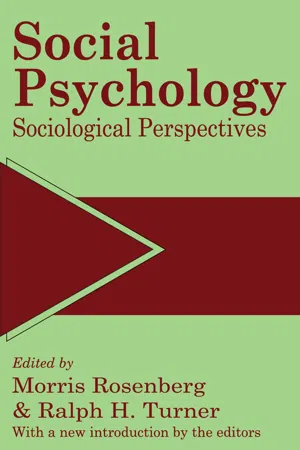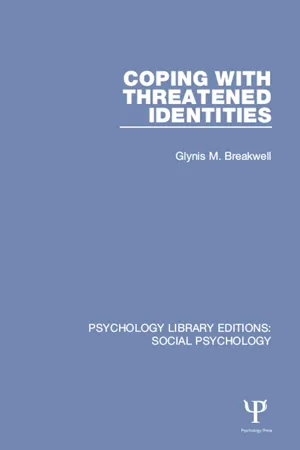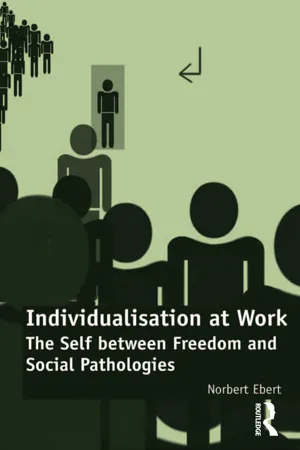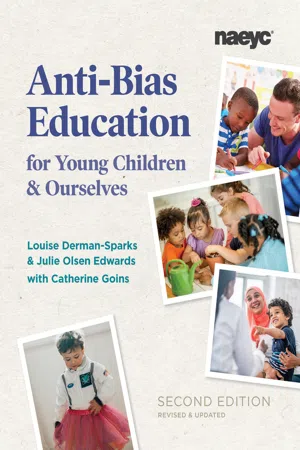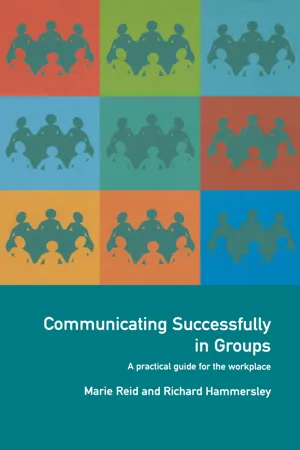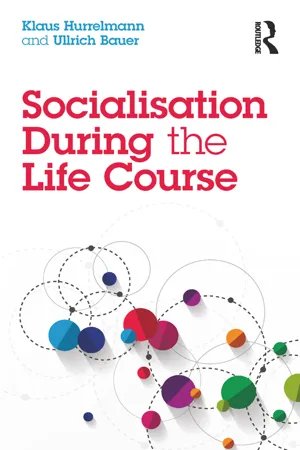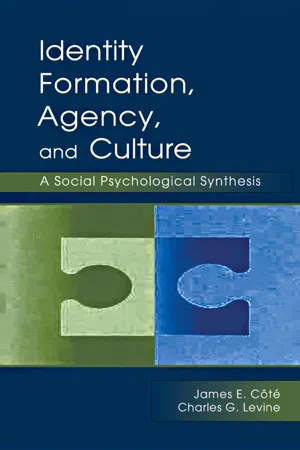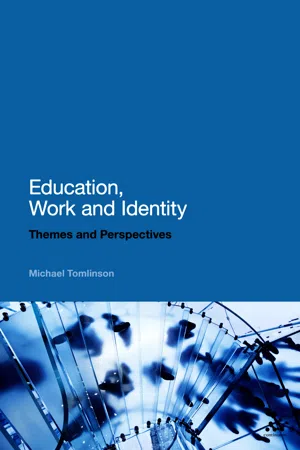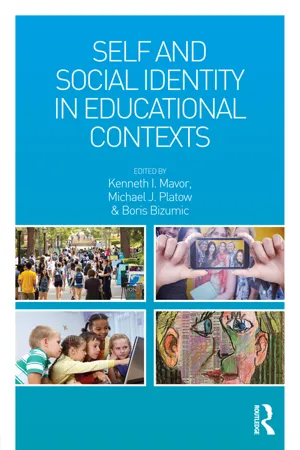Social Sciences
Socialisation and Identity
Socialization refers to the process through which individuals learn and internalize the values, norms, and behaviors of their society. It occurs through interactions with family, peers, media, and other social institutions. Identity, on the other hand, encompasses the characteristics and traits that define an individual, including their sense of self, belonging, and social roles, which are shaped by socialization experiences.
Written by Perlego with AI-assistance
Related key terms
Related key terms
1 of 4
Related key terms
1 of 3
10 Key excerpts on "Socialisation and Identity"
- eBook - ePub
Social Psychology
Sociological Perspectives
- Ralph Turner(Author)
- 2017(Publication Date)
- Routledge(Publisher)
In keeping with their disciplinary origins, sociological definitions of socialization tend to emphasize the ways in which the individual learns to fit into society, and, to a lesser degree, how this process changes not only the individual but society as well. Many definitions make the point that processes of socialization vary immensely in terms of explicitness, formality, and specificity (Clausen 1968; Elder 1975), often depending on characteristics of the socializee such as age, the relationship between socializee and agent of socialization, and the context of socialization (see chapter 6). Virtually all sociological definitions of socialization emphasize the distinctly social nature of the processes of socialization. For sociologists, processes such as imitation, identification, and role acquisition are viewed as social interactions; the interaction is reciprocal and the socializee is not passive, but takes an active part in the process. Among sociologists, there seems to be substantial agreement that socialization serves to maintain social groups by promoting the adaptation of the individual to them; in this sense socialization is beneficial to both the individual and society. Sewell (1963) defines socialization as “processes by which individuals selectively acquire skills, knowledge, attitudes, values and motives current in the groups of which they are or will become members.” In this definition and in many others (Baumrind 1975; Zigler and Child 1969; Mortimer and Simmons 1978), socialization is a symbiotic process with some positive outcomes for both the social group and the individual. Likewise, those definitions that emphasize acculturation propose that socialization not only enables the socializee to adapt, but that it is the way in which culture and societies reproduce themselves (Inkeles 1968) - eBook - ePub
- Glynis M. Breakwell(Author)
- 2015(Publication Date)
- Psychology Press(Publisher)
The data on self-awareness all point to the fact that people can distinguish personal from social identity and that the momentary dominance of one or the other will shape behaviour. This, however, begs the question of the origins of personal identity. The formulations which segment identity like a cake cut into portions never explain the processes which produce a distinctive entity like personal identity. What is really required is a theory of the development of personal identity across time. It is known that at a single moment in time personal and social identity can be separated: the person experiences them as different. The real question is whether developmentally they are separate or whether personal identity is some product of social identity. It could be argued that personal and social identity are merely different points in the process of development.The person actively accommodates to and assimilates conceptions of the self provided by the social world. Social roles provide a structure for self-description and are hemmed by social values which generate self-evaluation. The individual moves through a sequence of social roles, adopting the social identity appropriate to each sequentially, and sometimes simultaneously, layering them one on top of another. Personal identity could be considered the relatively permanent residue of each assimilation to and accommodation of a social identity. It is what remains when the exigencies of social context that demand acceptance of a particular social identity fade. To this extent it is autonomous of immediate social events but at root fundamentally dependent on them.Breakwell (1983a) argues that this developmental conception of personal identity does not imply any crude social determinism. There are too many contradictions between social roles and the ideologies appended to them for their effects to be anything but subject to the active interpretation of the individual concerned. Perception of social pressures and adaptation to them selective, and it is an active process. Personal identity may be said to be the residual product of this active process but it is also an inherent part of the process itself; even the principles of selection which guide adaptation are the consequences of past experiences. In real time, the evolution of identity entails this continual and truly dialectical relationship between personal and social identity: - eBook - ePub
Individualisation at Work
The Self between Freedom and Social Pathologies
- Norbert Ebert(Author)
- 2016(Publication Date)
- Routledge(Publisher)
But it is not sufficient to portray the self as a social self; there is more to its constitution. In particular, the Chicago School of Symbolic Interactionism, originating mainly in George Herbert Mead’s concepts, gave high priority to the process of negotiation. ‘Meaning is viewed as an emergent of this fluid and reciprocal process of interaction’ (Gecas 1982: 10). Individuals are seen as active and creative actors who are able to construct their social environment and themselves. Accordingly, the social self is seen as a dynamic, changing actor, never ‘becoming anything’, but always ‘in the state of becoming’. This suggests that the self not only negotiates the social order, but the very process of negotiating defines its very nature and existence. The individual is not socialised once, but is always in the process of socialisation; it is not set or fixed, but constantly undergoing change in the process of social interaction (Charon 1979: 30). Thus it is social interaction that fundamentally characterises the permeable boundaries between the individual and society, and the normative flexibility of human beings. As explicated by Joas,The prototypical case is of social relations in which action does not take the form of mere translation of fixed prescriptions into deeds, but in which definitions of the relations are, rather, jointly and reciprocally proposed and established. Social relations are seen, then, not as stabilised once and for all but as open and tied to ongoing common acknowledgments. (1987: 84)This open-ended malleability forms, we can suggest, the basis for the currently popular demand for an openness to ‘life-long learning’; it also seems a necessity and essential quality of individuals in hyper-differentiated work societies. To further clarify this I will base my following discussion on the differentiation of ‘socialisation’ and ‘individuation’.Starting with a discussion of socialisation (I will address individuation separately in section 2 of this chapter), Mead’s concept of the ‘generalised other’ is most relevant here. ‘The attitude of the generalised other is the attitude of the whole community’ (1972: 154). These attitudes become normative guidelines for the self’s own behaviour and thus shape the individual. This fundamentally constitutes the first meaning of normative individualisation. Beyond this, Mead went on to differentiate between ‘I’ and ‘Me’ as constituents of the self.2 - Louise Derman-Sparks, Julie Olsen Edwards(Authors)
- 2020(Publication Date)
Personal identity is what most early childhood teachers think about when they consider ways to nurture children’s positive self-concept. It includes factors such as a person’s name, personality, talents, interests, age, and the specifics of and relationships with family members. These attributes are what give each person a sense of individuality. Personal identity is primarily fostered by a child’s temperament, home, and extended family, and then by community and school experiences.In contrast, social identity refers to the significant group categories that are created and defined by the society in which people live. These include culture, economic class, family structure, gender, language, race, religion, and more. In addition, societal attitudes toward physical attributes such as body size and shape make them part of people’s social identities. For example, one child’s social identities might include being male, East Coast urban, African American, Muslim, and from a two-parent, middle-class family. A second child’s social identity might include being female, White, rural, Christian, English and Russian speaking, and from a working-class, grandparent-led family. A third child might be gender fluid, West Coast urban, Jewish, and from a professional, blended family. Some of these social identities receive support and approval within the dominant culture. Some are diminished and defined as “other.” Every social identity has societal policies, stereotypes, and attitudes connected with it. These may affect how teachers view the children and families with whom they work as well as how they think of themselves.At various times in one’s life, some social identities may play a more important part than others. A person might also have shifting feelings about various social identities—being proud of some identities and downplaying or denying others depending on the circumstances of that person’s life. Some social identities may shift throughout life: Economic class may shift. Marital status and family structures may evolve. Religious identities may change.- eBook - ePub
Communicating Successfully in Groups
A Practical Guide for the Workplace
- Richard Hammersley, Marie Reid(Authors)
- 2014(Publication Date)
- Routledge(Publisher)
6 The social construction of identityObjectives
By the end of this chapter you should understand the six basic ideas about identity that are listed below.Basic ideas about identity
We will draw upon both psychology and sociology and offer you six basic ideas:- Identity is fluid, dynamic and negotiable.
- Identity is communicative. We signify our social identities to other people, interpret feedback from them about what we are like and may modify our identities on the basis of that feedback.
- Our stable personal identities are constructed to make sense of what has happened to us and how we have related to other people.
- People’s identity constructs are usually socially functional for them, and this can apply even to deviant, damaged or spoiled identities.
- Identity involves identification with specific groups of people, but also contribution to the nature of those groups; this is a fundamental aspect of social activity.
- People routinely adopt different identities in different social groups; hence the idea of a social role.
The last two points will be covered in detail in other chapters. It follows from these key points that although you are often defined by your interactions with others, you can also change yourself and how others see you. Furthermore, this is easier to accomplish if you have good communication skills and awareness of how social processes work. To a certain extent it is possible to adjust your identity by managing how others perceive and judge you, although this does not mean that you should be manipulative about it. Indeed, people tend to disapprove of others who are overly concerned to present whatever identity seems the most socially convenient at the time.Identity is fluid, dynamic and negotiable
As we will see in Chapter 10 - Mardi Horowitz(Author)
- 2014(Publication Date)
- Routledge(Publisher)
Chapter 4Social learning and identity formation
Social interactions shape individual identity formation and self-organizational maintenance. The intra-psychic schemas of self and other contain the precipitants and generalizations of the interactions. The most important social residues are role-relationship models since these models organize traits of self in affiliation with attributes of others in networks that include transactional scenarios or scripts, values, and potentialities for emotional expressions.The transmission of meanings in cultures is not necessarily clear in the sense of verbal descriptors. The residues of the meanings from cultures, within a person, are not necessarily conscious. The important issue is that both levels, social and intra-psychic, are often implicit rather than explicit, procedural and enacted rather than declarative in the form of verbal statements. Exploring the social derivations of identity qualities is one aspect of that famous Freudian phrase, making the unconscious conscious.Where Freud emphasized instinctive biological drives such as the libido and aggression, Erik Erikson emphasized self-development within social structures, starting with extreme dependency on caretakers. He developed important models of how to examine identity formation in social contexts in this early phase and connected them to subsequent development in a model of the human life cycle. He summarized the key acquisitions of identity features in a slowly maturing self, operating for survival within a culture, a culture that existed before birth, and a culture that itself might be changing (Erikson, 1950, 1959, 1968; Bion, 1997; Erikson & Erikson, 1998).A contemporary model of the sequential development of self was summarized in Chapter 3 , in Table 3.2- eBook - ePub
- Klaus Hurrelmann, Ullrich Bauer(Authors)
- 2018(Publication Date)
- Routledge(Publisher)
CHAPTER 5 Socialisation in the individual life stagesThe explanations in the previous chapter show how much the individual stages of the life-course have shifted and changed in their extent and form over the past 100 years. Some of the challenges resulting from this restructuring of the life course for the biographic organisation and socialisation have already been mentioned. Today, a very open form of the life course is predominant, which enables a ‘chosen biography’ but also requires a demanding ‘biography management’. As has been shown, the implementation of such a biography management often fails today due to a lack of personal competences, but also due to persisting traditional, social, legal and institutional regulations stemming from the era of the alleged standard biography.This chapter will discuss the critical demands for the productive processing of internal and external reality in the individual life stages of childhood, adolescence, adulthood and seniorhood. Particular account is taken of the differences according to social background. It aims at identifying the structural problems occurring in coping with the developmental tasks to be mastered in the respective stages. This is done on the basis of the classification of developmental tasks in four groups described above: ‘Qualifying’ , the task of developing the competences necessary to cope with the social and performance requirements, as well as for later professional tasks; ‘bonding’ , the task of accepting the physical development and gender identity, and establishing partner relationships; ‘consumption’ , the task of developing the abilities required for dealing with the economic, leisure and media markets; and ‘participation’ , the task of developing a system of values and norms required to assert one’ s own interests and participate in shaping the community. - eBook - ePub
Identity, Formation, Agency, and Culture
A Social Psychological Synthesis
- James E. Cote, Charles G. Levine(Authors)
- 2014(Publication Date)
- Psychology Press(Publisher)
In late modern societies, therefore, social identities are much more precarious than ever before. As opposed to being a birthright, or a sinecured social achievement, one’s legitimacy can be continually called into question. In order to find a social location to begin with, one often has to convince a community of strangers that one is worthy of their company, and this acceptance can be challenged virtually at any moment. Individuals now have to manage their lives by strategically finding their place or places, often repeatedly over their life course. Thus, in contrast to the past, it is common for people to move through a series of educational settings, jobs and careers, romantic relationships and marriages, and neighborhoods and urban settings, possibly gaining and losing acceptance a number of times.At the level of interaction (i.e., the interpersonal world where culture and individual meet), corresponding personal identities are largely heteronomous, then individuated, and then image-oriented as we move through the three types of societies. The heteronomous identity is based on an un-reflexive acceptance of others’ appraisals and expectations that produces a conformist and mechanical blending into a community; the individuated identity is one that is based on the production of a distinctive personal style and role repertoire by which the person’s biography leads to an organic integration into a community; and the image-oriented identity of late modernity is based on a projection of images that meet the approval of a community, gaining one access so long as the images remain acceptable. Personal identity refers here to interpersonal styles that have been shaped by the actual life experiences of people. In a sense, it expresses the culmination of an individual’s “biography of everyday life” at a given point in time.In late modernity, then, personal identities can be even more precarious because the standards of acceptable behavior continually change. As a result, people experiment with various ways to present themselves, and change their appearances regularly (or even their names, much to the chagrin of genealogists or those concerned with intergenerational continuity). Much day-to-day interaction is with strangers or acquaintances who do not know each other’s biography (and may not care), and who do not know or care if they ever see each other again. What is important is how the present is constructed, and this is most easily done through personal experiences and appropriate conversation. Consequently, what often counts is the image one projects, rather than the substance of what is behind the image. This, of course, is standard fare among the most recent cohorts of young people. A passage from Wheelis’s (1958) - eBook - ePub
Education, Work and Identity
Themes and Perspectives
- Michael Tomlinson(Author)
- 2013(Publication Date)
- Bloomsbury Academic(Publisher)
The notion of learner identities and trajectories is important as it relates to individuals’ specific frames of references, lived experiences and future orientations towards learning and work. Learner identities play a potentially potent role in framing the parameters within which people make choices and understand their wider position both within the educational system and beyond in the labour market. These identities often guide people’s choices and their propensities towards various forms of future educational and work-related activity. However, people’s learner identities are also socially and contextually mediated and not simply individually constructed. This works on a range of levels, from the broader socio-economic and policy context through which learner opportunities are structured, through to individuals’ location within the social structure – in particular, their class position, gender and ethnicity.The chapter seeks to further locate the analysis of learner identities in relation to wider sociological theories of learning, linking this to wider themes of the social and cultural mediation of the learning experience. This is linked to a discussion on the wider policy concept of lifelong learning , and how this has been conceptualized and applied in research with a range of different groups, not least those in post-compulsory and adult-based education. In particular, the way these are shaped by the wider social and educational contexts that frame their experiences. At the end of the chapter, we explore the issues of work-related learning and how this is mediated by the different contexts in which people work.Lifelong learning for a learning societyThe concept of lifelong learning gained increasing popularity in the 1990s, driven largely by the UK Labour government’s attempt to create a so-called ‘learning society’. The underlying rationale for lifelong learning is based on both economic and social justice imperatives. As the concept implies, lifelong learning refers to individuals’ engagement in learning throughout their life course, moving beyond that which is confined to formal educational settings. Lifelong learning is presented as an economic necessity that helps meet the needs of a changing economy through the enhancement of individuals’ skills. It also opens up opportunities to participate in learning among those social groups who have typically been excluded from formal learning opportunities (Coffield 2000). Clearly, governments have enunciated the significance of learning for both economic gains and as a mode of social inclusiveness. The DfEE (1998) report ‘The Learning Age - eBook - ePub
- Kenneth I. Mavor, Michael J. Platow, Boris Bizumic, Kenneth I. Mavor, Michael J. Platow, Boris Bizumic(Authors)
- 2017(Publication Date)
- Routledge(Publisher)
As a result of these benefits, it is important to understand how educational identity can be fostered and nurtured, especially during times of academic transition that risk undermining the development of such an identity. As in other aspects of life, in the context of education, people are constantly transitioning (e.g., Antaki, Condor and Levine, 1996). Educational identities are necessarily transient as people progress through the educational system – from primary school to secondary school and possibly on to university. How do people navigate these identity transitions and come to adopt (or not) different educational social identities?In this chapter, we explore the motivational factors that determine when and why people come to identify with educational groups. We adopt a theoretical framework outlined within self-determination theory – a theory of human motivation based on the satisfaction of three basic needs: autonomy, relatedness and competence. We employ this theory alongside the social identity approach and discuss how psychological need satisfaction underscores the development of educational social identity. We propose that individuals will be more likely to identify with educational groups when those groups satisfy members’ motivational needs for autonomy, competence and relatedness.The social identity approach to education
Education researchers have long considered identity as an important ingredient in the educational process (e.g., Gee, 2001). Students are more likely to engage with the academic process if they adopt identities of ‘student’ or ‘learner’ into their self-concept (Osbourne and Jones, 2011). This process of identification influences students’ sense of belonging within the learning environment, which in turn affects their learning outcomes. Baumeister, Twenge and Nuss (2002) demonstrated the detrimental effect of lack of belonging on higher-order cognitive processes such as reasoning and comprehension. Similarly, Stephens, Fryberg, Markus, Johnson and Covarrubias (2012) revealed a reduction in academic performance for students whose social background did not match with the cultural norms of the educational context (see also Jetten, Iyer and Zhang, Chapter 6
Index pages curate the most relevant extracts from our library of academic textbooks. They’ve been created using an in-house natural language model (NLM), each adding context and meaning to key research topics.
Explore more topic indexes
Explore more topic indexes
1 of 6
Explore more topic indexes
1 of 4
